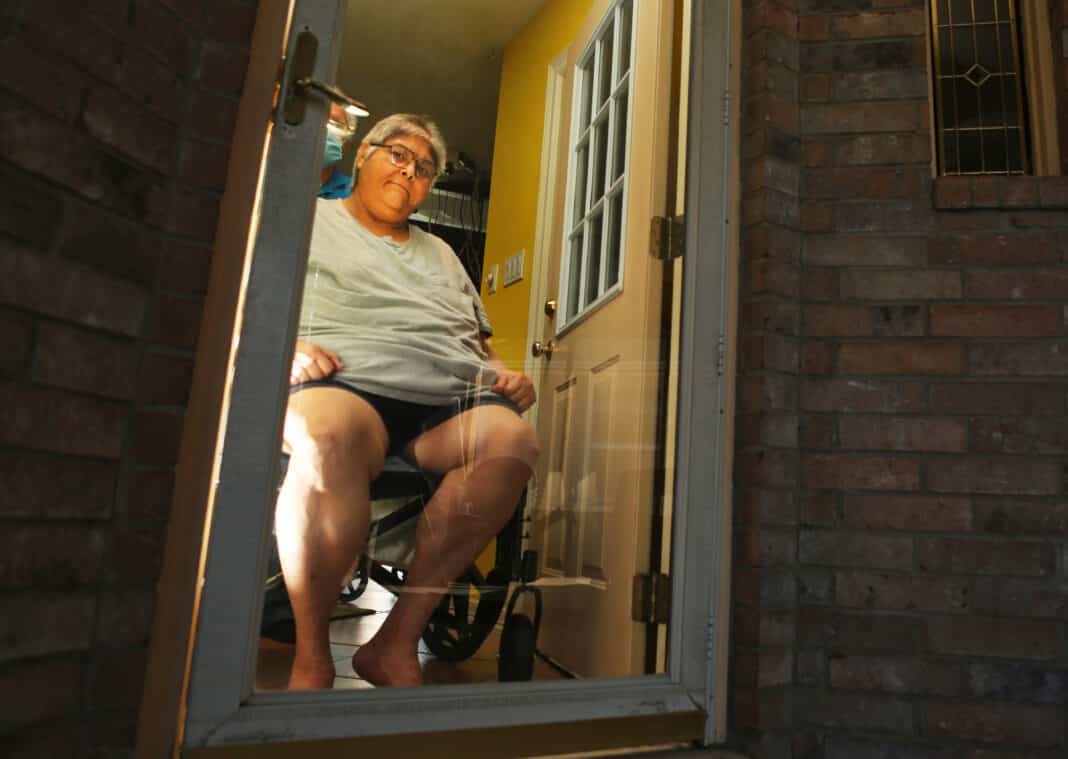Mario Loya, 63, lives alone in his La Feria residence. Illness keeps him home and confined to a wheelchair. Vaccines to prevent COVID-19 are out of reach for him and nearly 17,000 other Rio Grande Valley homebound residents.
“They don’t know how to get to us,” Loya said succinctly describing the situation public health officials are facing trying to reach his demographic — eligible, unhealthy and out of reach.
Loya struggles with diabetic neuropathy — a diabetes complication that leads to nerve damage. A caregiver visits him to help with daily tasks, but they are not able to physically lift his wheelchair into a vehicle. Loya hires other people to help with chores like cutting the grass.
Over the summer, Loya’s yard was visited by a landscaper. “The gentleman had to come in so I could give him the money.” This brief interaction proved troublesome later when the man who cut the grass found out he was sick.
“Once he found out, he was in the hospital by then,” Loya said recalling the incident. He placed himself in quarantine hoping he didn’t catch the virus. No symptoms developed, and Loya believes he didn’t catch the virus. Though, he did not get tested due to his immobility issues.
Homebound residents are exposed to the virus while computer literacy, the digital divide, illness, a lack of adequate transportation or care pose obstacles to vaccine access.
The Lower Rio Grande Valley Development Council, or LRGVDC, and specifically the Area Agency on Aging, is involved in helping compile data for public officials interested in calculating the amount of people living like Loya.
“It’s a significant number of seniors,” Jose L. Gonzalez, the Area Agency on Aging director, said.
Gonzalez said they’re looking to different data sources to pool totals.
Across the Valley, Gonzalez said there’s 290 home health agencies providing services to 11,000 people, 160 adult day cares serving 1,500 seniors, nearly 2,500 residents are receive delivered meals from the LRGVDC-contracted Amigos Del Valle, and about 2,000 people, including family caregivers, are Area Agency on Aging case management clients.
Gonzalez said his estimates for people who are 65 years of age or older and who are Medicare beneficiaries in the Valley are over 145,000, that doesn’t include the transient Winter Texan population. This demographic is the target for the vaccines.
Identifying the eligible homebound residents is the first part of a multifaceted process.
“We have to figure out a way to register those seniors,” Gonzalez said.
Some seniors are not computer literate but could get help from a relative, if possible.
For those who do not have internet access, a service announced on Friday by the Department State of Health Services could help.
Texas residents can dial 2-1-1 for information and referral to a local vaccine provider. However, registration continues to be mostly online or in-person.
Senior centers and nutrition sites may play a role in vaccine coordination, Gonzalez postulated. “Set it up where seniors can go and grab their meals and along with grabbing their meals get a vaccine,” he said.
Mobile sites where providers drive to the homebound resident are also under consideration. Logistics for handling time-sensitive vaccines is a challenge.
Gonzalez said 9-1-1 information was used to map the possible vaccine delivery routes, but it proved too daunting a task. Currently, they’ve turned to the American Association of Retired Persons, or AARP, a national organization who Gonzalez believes could have the means to do the research and offer help.
Gonzalez said he sent a list of local zip codes to an AARP representative. He asked “if they can tell us how many 65+ live within a specific zip code. Maybe that’s something that we can do for targeting.”
A response is pending.
Cities and counties are collaborating but also working independently to find solutions.
“We’re compiling a master list working with adult day care centers and Amigos del Valle,” Pharr Commissioner Ramiro Caballero said during the city’s first vaccination clinic on Friday.
Some of the day care centers also offered to drive people to centers, but there are over 100 people living within the city’s jurisdiction who cannot leave their homes.
Public health officials who decide on using a mobile site that delivers the vaccine will also be tasked with finding the required human resources. Retired nurses could be an option, David Garza, Cameron County Commissioner of Precinct 3, said during a call over the weekend.
Garza said he’s been talking about this population in weekly meetings with the mayor of McAllen and the development council.
Transportation, routing, human resources, and registration problems aside, Garza said, “The biggest issue is where do we get the vaccine.”
A woman living in a community of older people recently asked him, “Can you bring the vaccine to us?”
Loya wonders the same.
On Wednesday he stepped out of his house for the first time since the pandemic. His neighbor, who is a caregiver for his mother living next door to Loya, offered to take him for breakfast.
“I was so happy to be out. The air felt so good,” he said. He went back inside where he waits for the next time he can be out in a safer environment.





